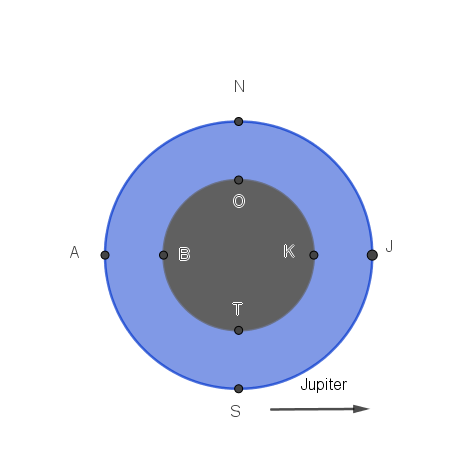Group2 19-1 Week5
How long does the mission need to last?
Europa could possibly be regarded as being spherically symmetric, were it not for Jupiter’s strong gravitational influence on her. Many processes are probably highly influenced by Jupiter, either positively or negatively. Since we don’t know for sure what processes can sprout life and/or how those processes are influenced by external gravity, it can be interesting to search for life both on the Jovian and the Anti-Jovian side of Europa.

Regard the picture to the right. The surface points indicate the surface of the ocean, below the crust, and are noted as Jovian (J), Anti-Jovian (A), North (N) and South (S). The seafloor points have the same letters, shifted 1 forward. To search the Jovian and Anti-Jovian poles, the lines AB and JK make the most sense. Have the submarine sail across these lines and take a sample every so often. To travel between these lines, the semicircle BOK or BTK seems most logical because the radius of these circles is the smallest possible. The total route ATOKJ is 4700 km. However, that does require that the submarine can remain at seafloor levels of pressure for extended periods of time (on the order of years). To avoid this, the route ATANJK can be taken. This one, however, is 5320 km. The observant reader may have noticed that 5320 km is A LOT. A car driving on the Dutch highways will have to drive from Groningen to Maastricht and back almost 8 times. This will take roughly 60 hours. Bathyscaphe Trieste (the first submersible to reach the bottom of the Challenger Deep) submerged and resurfaced with an average speed of 0.9 m/s, with which it would complete the journey in 68 days, ignoring the fact that Trieste could only go up and down. The Trieste submersible had a mass of 14 metric tons. This is obviously much too big. However, it was made to harbor 2 people and protect them from the immense pressure, which we don’t need. The inside pressure needs only be small enough that the equipment can still function. On the other hand, our submersible needs to withstand double the pressure that Trieste did. Furthermore, Trieste used gravity to sink and rise, which is much lower on Europa. All in all, the maximum diving speed of the submersible may cap out well below 1/10 of Trieste’s speed. Furthermore, the lateral speed of the submersible is probably even lower, due to complicated driving systems. Since the exact velocity of the submarine is difficult to estimate precisely at this point, we will accept this 0.05 m/s as the actual top speed. At this velocity, the long route takes 3.37 years, and the short route ‘only’ 2.98 years. Only going back and forth between the ice and the seafloor takes 70 days. This is a total distance of 300 km. Please remember that this is calculated in a straight line, completely ignoring the fact that the route straight down may not be possible due to obstructions, or desirable due to interesting finds along the way. All this also disregards the dig down to the sea. Valkyrie achieved a velocity of 0.9 m/hr. This means it would take 46 days to dig through the crust. Combine this with a startup time, communications check, and pre-disembarking measurements, and the total time before setting off could easily be 60 days. Considering the interest in both the Jovian and anti-Jovian poles of Europa, the ATOKJ is likely most useful. To allow for deviations, we will add an estimated 41% length to the route; this will allow a deviation off the route of 45 degrees at all times. At an average speed of 0.05 m/s, this will take an estimated 1538 days, or 4.21 years. Add the 60 days to get 4.4 years. Plus some room for error, we’re looking at a mission of between 4.5 and 5 years.
Navigation
Going up and down by making the total density equal to water, but adding a piston filled with a fluid that is just slightly more compressible than water to the outside of the submarine.
Parts list
Surface base:
- Fixation stuff
- Power source
- Communications
- Emitter
- Receiver
- Research equipment
- Seismometer
- Spectrometer
- Camera
- Gas emission experiment tools
Digger:
- Digging stuff
- Power source
- Shielding
- Battery
- Accelerometer
- Fixation stuff
- Communications
- Emitter
- Receiver
- Cable
- The cable is with the digger to avoid having to drag all that length of cable all the way through the ice, and to make sure that it's possible to unroll the cable
Submarine:
| scope="col" width="width:20em;" | Volume | Weight |
|---|---|---|
| Barometer | d=4 cm, r=5 cm | ~50 g |
| Propulsion | ||
| Up-down | ||
| Sideways | ||
| Gyroscope | in computer | negligible |
| Accelerometer | in computer | negligible |
| Research equipment | ||
| Gas emission | ~30x30x30 cm | ~2.5g |
| Camera x2 (each) | 6.2x4.5x2.8 cm | 100 g |
| Spectrometer | 6x8x2 cm | 100 g |
| Pressure-resistant hull | ~15 cm external | dependent on dimensions |
| Power source (100 W?) | 9 cm3 | 170 g |
| Shielding | 0.51 cm | 200 g |
| Reloadable battery | new prototype battery has power density of 10 microwatts per cubic centimeter, so for 100 W size of 10 m3? | |
| Cummunications | ~10x5x5 cm | ~200 g |
| Emitter | ||
| Receiver | ||
| Method to sample water | 1 L | 2 kg |
| Lights | 0.06 m3 | 1 kg |
| Computer | 1 L | 3 kg |